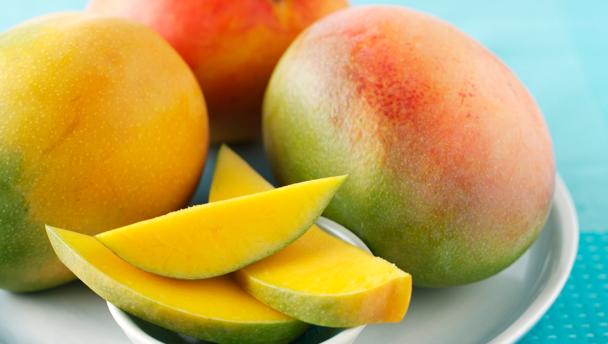

The fragrant sweetness, rich flavour and succulent texture of this magical fruit is highly seductive. To test a mango for ripeness, press the ends firmly - if they yield slightly to the pressure, they should be ready to eat. Otherwise, if it's not quite ready, mangos can be left to ripen in a sunny spot.
 Thai beef and mango salad
Thai beef and mango salad
 Spicy chickpea burgers with mango salsa
Spicy chickpea burgers with mango salsa
 Caribbean toastie cups with avocado, mango and mint
Caribbean toastie cups with avocado, mango and mint
 Mango passion with honey and yoghurt
Mango passion with honey and yoghurt
 Festive fruit salad with brandy snap
Festive fruit salad with brandy snap
 Fruity kebabs
Fruity kebabs
 Mango and white chocolate cake with toasted coconut
Mango and white chocolate cake with toasted coconut
 Golden flapjacks with mango, sour cherries and coconut
Golden flapjacks with mango, sour cherries and coconut
 Sweet meringue
Sweet meringue
Mangoes are now grown in many tropical and sub-tropical regions and come in a wide variety of shapes, sizes and colours. They can be round, oval, kidney-shaped or egg-shaped, with yellow, green, red or purple-flushed skin. Their stones can be large or small, their skin can be thin or thick and their flesh yellow or orange, with varying degrees of fibrousness.
The majority of Asian mangoes have a delicate skin and a short shelf life. For that reason, they're flown into Britain (mainly from India and Pakistan), so are more expensive. The thicker-skinned varieties, such as Keitt and Kent, are shipped in by sea year-round. Importers follow mango seasons from country to country. The chief exporters of thick-skinned mangoes are Puerto Rico, Mexico, Israel, South Africa and Peru.
Everyone has their favourite type of mango although there's no doubt that some of the Asian varieties have a particularly fine flavour and soft, non-fibrous texture. Below is a guide to some of the main mango varieties and their seasons, but it's worth experimenting because some supermarkets now sell what they consider to be top-quality varieties throughout the year.
Alphonso (April to June), mostly from India, is often described as the king of mangoes. These thin-skinned fruits are undoubtedly delicious with their intensely flavoured, fragrant, sweet, juicy and meltingly soft flesh.
Chausan (June to August), from Pakistan, has a thin yellow skin streaked with green and the sweetest of sweet, smooth-textured flesh. It is sometimes called Honey.
Keitt and Kent (year-round), the best known thick-skinned mangoes, are modern varieties, developed in Florida in the early 20th century and widely sold in supermarkets. They come from South and Central America, The Gambia and other places. They're more fibrous than Alphonso and Kesar varieties, with a stronger sweet-sour taste that works well in Caribbean-style salsas.
Kesar (May) is a wonderfully sweet, juicy and aromatic thin-skinned mango from India and Pakistan.
Maya (mid-July to August), from Israel, has a thick yellow-blushed skin that hides sweet juicy, smooth-textured flesh.
Nam Doc Mai (February to March) is a thin-skinned sweet juicy fibreless mango from Thailand. In Thailand this variety is usually eaten ripe, but in other countries, it's often sold unripe for recipes requiring green mangoes. These can be found in most oriental supermarkets.
Tommy Atkins (year-round) is another thick-skinned mango that was developed in Florida and is now grown in South and Central America and The Gambia. It has a light fruity flavour and a moderately fibrous texture.
Thin-skinned mangoes are best for eating raw or, when unripe, using in chutneys. Thick-skinned mangoes are better for South American-style salsas and European-style puddings. Try them mixed into a pavlova topping or chopped into fruit salads. If not fully ripe, it's worth letting them ripen on your windowsill to maximise their flavour. They're ripe when they gently give at their stem end. Colour isn't a reliable indication of ripeness because some varieties remain green even when ripe. Mangoes should be kept at room temperature, rather than chilled, to maximise their flavour.
Type the ingredients you want to use, then click Go. For better results you can use quotation marks around phrases (e.g. "chicken breast"). Alternatively you can search by chef, programme, cuisine, diet, or dish (e.g. Lasagne).